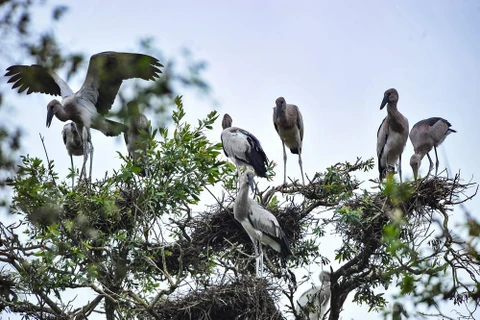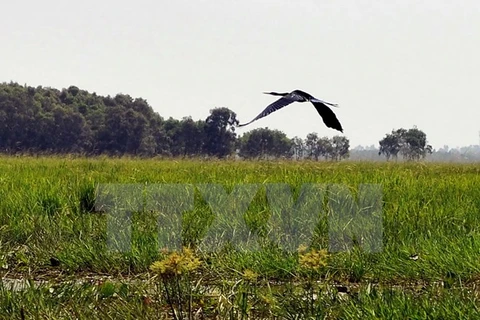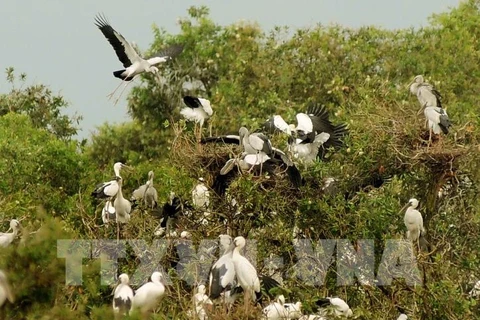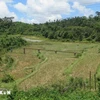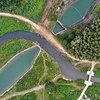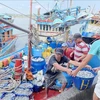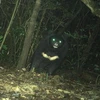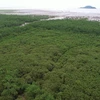Dong Thap (VNS/VNA) - Located in the wetlands of the Plain of Reeds in the Mekong Delta province of Dong Thap, Tram Chim National Park is known for its spectacular diversity of bird species, attracting bird-watchers year-round.
Local farmers named the park Tram Chim due to the great number of cajeput (tram) trees and birds (chim).
The 7,300ha park, flooded for half a year and dry for the other half, is home to more than 100 vertebrate species, 40 species of fish, and 213 species of water birds, including 16 rare birds like the Sarus crane, the greater adjutant, black-headed ibis, darter, and little egret.
Nguyen The Hanh, vice director of the national park, said that thousands of Asian openbill storks, which were given priority for preservation, have flocked to the park.
The park has a good environment for birds, containing a level of water conducive to the development of flora and aquatic creatures.
Thanks to its diversity of bird species, the park holds bird-watching tours, attracting a great number of visitors.
The number of visitors exceeded 60,000 in 2014, a five-fold increase compared to 2012, when it was recognised as Vietnam’s fourth site under the Ramsar Convention of Wetlands of International Importance.
In the first half of the year, the park welcomed more than 75,000 guests, an increase of 26 percent year-on-year. Tourism revenue in that period exceeded 3.8 billion VND (167,000 USD), up 81.5 percent from the same period last year.
The World Wild Fund for Nature Vietnam recently provided 2.6 billion VND (114,500 USD) for a project to encourage eco-tourism and sustainable use of natural resources in the park.
Pham Tan Xieu, head of the Dong Thap province People’s Committee Office, said the project would preserve the biodiversity of the wetlands and improve livelihoods for local people through community-based tourism.
In the late 1980s, under a Government programme to turn Dong Thap province into one of the country’s largest rice granaries, many canals, embankments and irrigation works were built, which led to degradation of the wetlands ecosystem.
The grass fields, which were food sources for the Sarus crane and other bird species, narrowed significantly, causing the birds to seek new shelter sites.
In an effort to retain the precious birds, the Government and conservation organisations have worked in the past decade to promote the migration of birds and cranes with million-dollar projects.
One of them was a project supporting habitat restoration and protecting the wetlands ecosystem in Tram Chim funded by the World Wildlife Fund (WWF) and Coca Cola, which operated from 2007-2014 in two phases.
The project helped increase by threefold the area of Eleocharis grasslands, a favourite food of the Sarus crane, drawing 125 cranes back to the park.
However, Hoang Viet, a programme coordinator of WWF Vietnam’s Freshwater and Climate Change, said that efforts to rehabilitate the wetlands habitat could be in vain if actions are not taken to restrict negative influences on the natural reserve.
The overuse of pesticides in agricultural production, for example, harms cranes, he said.
Despite many efforts to protect the bird population, a wild bird market in Long An province’s Thanh Hoa district, the biggest in the south, has been seen selling several species of rare birds, including darters and Asian openbills.
Though the province’s authorities have urged people to stop trading wild birds, the market remains busy.
Le Huu Loi, vice chief ranger of Long An province, said that authorities had imposed fines on eight people who sold endangered birds this year.
He said that many species of wild birds sold at the market were not on the list of endangered species banned from trade and hunting, and thus rangers could not punish traders.-VNA
VNA


